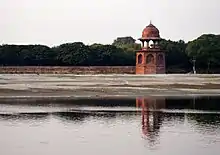Black Taj Mahal
The Black Taj Mahal, also known as the Black Taj, Kaala Taj, or The Second Taj, is a legendary black marble mausoleum that is said to have been planned to be built across the Yamuna River opposite the Taj Mahal in Agra, Uttar Pradesh, India. Mughal emperor Shah Jahan is said to have desired a mausoleum for himself similar to that of the one he had built in memory of his second wife, Mumtaz Mahal.[1]
| Black Taj Mahal | |
|---|---|
 Location in western Uttar Pradesh, India | |
| Location | Agra |
| Coordinates | 27.174799°N 78.042111°E |
| Elevation | 20 feet |
| Built | Was never built |
| Architectural style(s) | Mughal architecture |
A French traveller by the name of Jean Baptiste Tavernier who visited Agra in 1665 first mentioned the idea of Black Taj in his fanciful writings. The writings of Tavernier mention that Shah Jahan began to build his own tomb on the other side of the river but could not complete it as he was deposed by his own son Aurangzeb. However, many modern archaeologists believe this story to be myth.[2][3]
Background
Ever since the construction of Taj Mahal, the building has been the source of an admiration transcending culture and geography, and so personal and emotional responses have consistently eclipsed scholastic appraisals of the monument.
— Jean-Baptiste Tavernier, one of the first European visitors to the Taj Mahal
The belief holds that Shah Jahan planned a mausoleum to be built in black marble across the Yamuna river, with the two structures connected by a bridge. The idea originates from fanciful writings of Jean-Baptiste Tavernier, a European traveller who visited Agra in 1665. It was suggested that Shah Jahan was overthrown by his son Aurangzeb before it could be built. Ruins of blackened marble across the river in Moonlight Garden, Mahtab Bagh, seemed to support this legend.[4]
Myth


Many scholars, like Ram Nath, believe the idea of the Black Taj belongs to fiction rather than history. The traces which are identified as the foundations of the 2nd Taj are actually the enclosing wall of a garden founded by Babur. The irregular position of Shah Jahan's cenotaph in comparison to Mumtaz Mahal's, is similar to that at the tomb of Itmad-ud-Daulah, and thus should not be of any striking significance.[5] Besides, according to Islamic law, bodies are buried with their faces towards Mecca and legs towards the south, and the husband is placed on the right hand side of his wife. The interpretation that the cenotaph of Shah Jahan was not meant to be placed here appears to be superfluous.[6]
Modern excavations
Modern excavations carried out in the 1990s found that they were discolored white stones that had turned black.[7] As some believe that a more credible theory for the origins of the black mausoleum was demonstrated in 2006 by archaeologists who reconstructed part of the pool in the Mehtab Bagh (Moonlight Garden). A dark reflection of the white mausoleum could clearly be seen, befitting Shah Jahan's obsession with symmetry and the positioning of the pool itself.
Notes
- "Black Taj Mahal Myth". Retrieved 11 June 2013.
- Salim, Saquib. "The Real Story of Second Black Taj Mahal by R. Nath". HeritageTimes. Retrieved 23 September 2019.
- "Black Taj Mahal Myth". Retrieved 11 June 2017.
- "White Taj Mahal and Black Taj Mahal Story". Words of Wanderers. Retrieved 12 June 2013.
- Salim, Saquib. "The Real Story of Second Black Taj Mahal by R. Nath". HeritageTimes. Retrieved 23 September 2019.
- "The Story of a Second Taj". Retrieved 11 June 2013.
- "Black Taj Mahal Myth". Retrieved 11 June 2013.
References
- Bernier, Françoi' Travels in the Moghul Empire A.D. 1657–1668 (Westminster: Archibald Constable & Co.) 1891.